Remember when I said I was carefree last week? Yeah. About that.
Just after I scheduled Sunday’s substack to go out at 9am, I stashed my laptop in the seatback pocket on the plane. Fast-forward to me running off the flight, blissfully unaware… Until I got home and realized: no laptop. Anyone who’s ever left something behind on a plane (let alone their computer) knows the feeling.
Naturally, United was less than helpful. Every time I fly anything other than Delta, I’m reminded why I stick with Delta. But I digress.
My mom reminded me, “the squeaky wheel gets the grease.” I’d never heard this saying before, but I took it to heart. Motivated by that wisdom, I headed back to the airport, refusing to take no for an answer (respectfully). After speaking with six or seven different people, I finally found someone willing to go through security and retrieve it for me. All it takes is one. A few hours later, I walked out of the airport, laptop in hand.
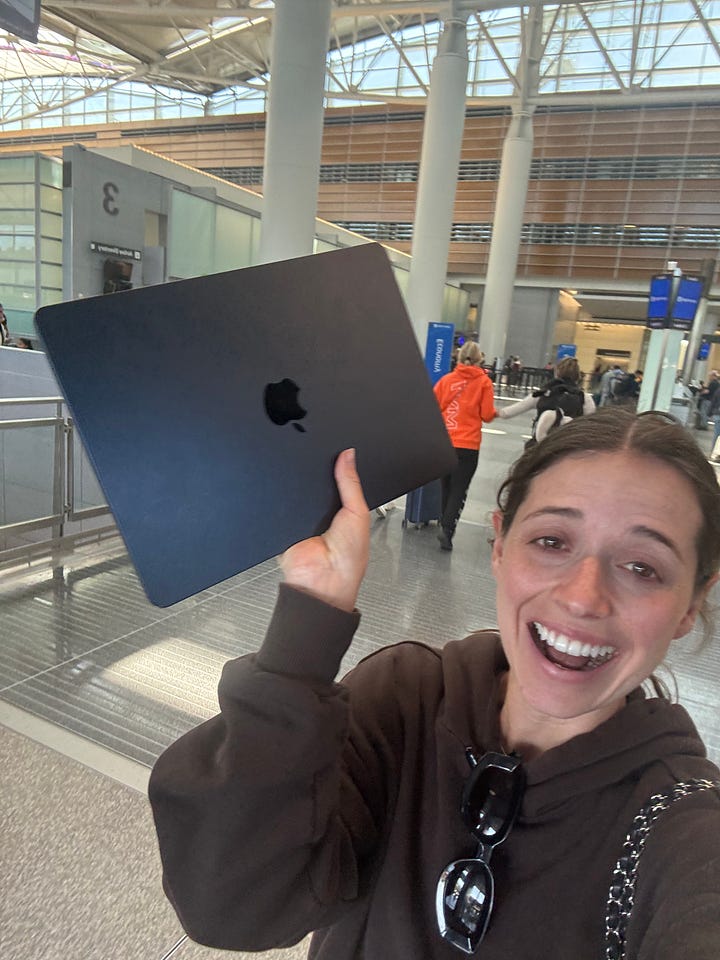
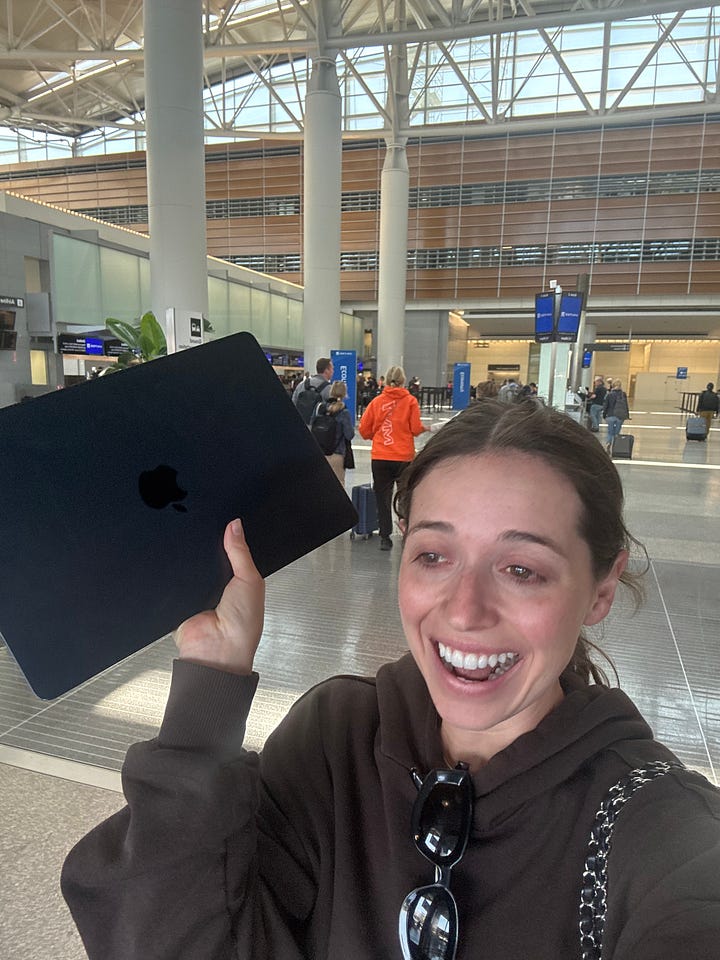
What I haven’t mentioned yet is that before all of this, back in Boston, I realized I’d accidentally booked my flight to San Francisco for July 19 instead of May 17. Somehow, a same-day ticket was cheaper than the one I mistakenly reserved two months in the future. Make of that what you will.
All of this is a long way of saying: I need to slow down. I move fast in the name of efficiency and productivity. I check things off without checking them twice. And more often than I’d like to admit, things fall through the cracks. This week, it was a flight and a laptop.
So that’s my summer resolution: slow down. Be present. Double check the details. Meditate a little more. Move a little less… frantically. And of course, we’re done with the seatback pocket.
With that in mind, here’s what I listened to this week. No through line on this one, but hopefully a few episodes that make you think, pause, or rewind.
1. Call Her Daddy: Jane Goodall
Jane Goodall is 91, still travels over 300 days a year, and just made history as Call Her Daddy’s oldest guest. She also might be its wisest.
Every night at 7pm, she raises a small glass of whiskey in honor of her mother, the voice behind her courage from the very beginning. On her 90th birthday, Jane celebrated with 90 off-leash dogs on the beach in Carmel. I just love her so much.
Jane always knew she loved animals. At 10, she saved up money from chores to buy Tarzan of the Apes and immediately decided she would live in Africa among the apes. Tarzan, she insists, “married the wrong Jane.” Years later, a philanthropist gave her enough money to go, but only if she brought a chaperone. So her mother joined her.
Since then, Jane’s lived with chimpanzees, made groundbreaking discoveries, married a National Geographic photographer, and carried a stuffed chimp named Mr. H around the globe to 60+ countries and counting.
But her mission still keeps her going, and she’s not ready to retire. Her most important work is now: helping people hold on to hope. Because that’s what she sees as the problem. Not just climate change or political division, but the creeping sense of helplessness. And her message is simple: you can’t solve all the world’s problems, but you can make a difference in your community. Start there.
Don’t like what you’re doing? Change it. Not sure what you want to be? Take a gap year. Want to be a homemaker? Be one. At the end of the day, it’s about being happy, and that rarely comes from more money or more fame.
Jane says she still tries to learn something new every single day. The best part about aging, after joking there isn’t one, is that the longer you live, the more you learn. And when asked what gives her hope? She doesn’t hesitate: young people. The ones already working to build something better than the world we have today.
Loved every minute of this one. So glad Alex gave her the mic!
2. On Purpose by Jay Shetty: Vlad Tenev
Robinhood co-founder and CEO Vlad Tenev sat down with Jay Shetty to talk money, mindset, and the kind of risk-taking that reshapes entire industries.
Vlad grew up in Bulgaria during a period of extreme inflation, watching money dictate every decision his parents made. They moved to the U.S. ahead of him, and when he finally joined them, it felt like meeting strangers. He didn’t speak English. He didn’t want to go to school. Kindergarten was brutal. But everything changed in first grade, when he realized he could read better than most of his classmates. The pressure to “make it in America” started early.
By 12, he was tracking stocks on Yahoo Finance and building a virtual portfolio. His parents saw an opportunity: score high enough on the SAT, and they’d give him that dollar amount to invest. He got a 1370. First stock pick? 3Com, the company behind the Palm Pilot. (Millennial core memory unlocked.)
At UCLA, he studied math and briefly flirted with academia before a roommate in finance convinced him the timing was right to build something. So he did.
He and his cofounder rented a house in South San Francisco, started writing code, and launched their first startup. Robinhood was their third idea, but the one that stuck. At the time, people were still paying fees to trade, making small-scale investing nearly impossible. So they flipped the model: zero commissions, no account minimums, and eventually, fractional shares. Now, anyone could buy $1 of Tesla instead of waiting to afford a full share.
He’s clear-eyed about the downsides. One of the biggest mistakes people make, he says, is buying stocks because someone on social media told them to. Use it as a signal, maybe, but think for yourself. And just start. Waiting is often the costliest mistake of all.
Robinhood’s users are young, optimistic, and betting on innovation: Tesla, Nvidia, Apple. Vlad believes the new American dream isn’t homeownership. It’s access to global markets. Investing, not just consuming.
He’s also realistic about public perception. After Dumb Money, he doesn’t expect accurate portrayals anymore (though he admits the actor nailed his mannerisms). The GameStop saga threw Robinhood into the zeitgeist. Before that, it wasn’t a politicized brand. Suddenly, it was.
His take on risk? Not taking enough is the biggest risk. If you’re too careful, you’re probably not pushing hard enough. Today, Robinhood has eight business lines generating over $100M each, and their most popular product ever isn’t trading. It’s their credit card, which had over 1M people on the waitlist before launch.
Vlad’s best advice: be honest… With others, but also with yourself. Worst advice? Trusting the “experts.” He listens, sure, but doesn’t follow blindly. His personal purpose? Seek truth. And if he could pass any law? He’d delete one. For every new law created, he says, one should have to go. Overregulation just creates “all sorts of problems.” Mood.
3. Money Talks: Don’t discount stores: how Walmart caught up with Amazon
A decade ago, Walmart looked stuck. Same-store sales were falling. E-commerce was an afterthought. Amazon had blown past it in market cap, and the story seemed settled: traditional retail had lost.
But then came the plot twist.
Since taking over in 2014, CEO Doug McMillon has quietly turned Walmart into a tech company disguised as a discount chain. Capex has doubled. E-commerce is growing twice as fast as Amazon’s. The company just posted a $1B quarter in online sales, and Wall Street has noticed. Walmart’s stock is up 50% in the last year and now trades at a higher multiple than Amazon, Apple, Meta, or Alphabet. Not bad for a company that sells more bananas than anything else.
The reinvention runs deeper than digital carts. Walmart has built one of the fastest-growing ad businesses in the country, earning $4.4B last year through placements in-store, online, and in-app. It now commands over 10% of U.S. digital ad spend. By 2027, ads alone are expected to generate 16% of Walmart’s operating profit.
And while the supercenters are still the face of the brand, the back end tells a different story. Tech is powering everything: from supply chains to pricing to personalization. It’s drawing real talent, too. Walmart is betting it can lure Silicon Valley brains to Bentonville, Arkansas, where it’s building a $1B campus across 350 acres. Whether that vision takes hold in small-town America is still TBD.
Yet even with its transformation, Walmart isn’t outpacing Amazon just yet. Logistics and product variety remain key gaps, and there’s growing debate over whether recent gains reflect long-term strength or short-term shifts. But here’s what’s clear: the market underestimated Walmart. And it’s now the biggest company in the U.S. by revenue, with $680B in annual sales and a valuation that reflects its shift from low-cost giant to tech-powered operator.
For the full backstory, listen to the Acquired episode on Walmart here. The Journal also has a great episode on its approach to store leadership here.
4. 99% Invisible: The Brutalists
I finally watched The Brutalist this past week, which served as the perfect lead-in to this episode of 99% Invisible. Host Roman Mars sits down with architecture critic Mark Lamster to unpack how architecture shows up in film, why everyone thinks they hate Brutalism, and what we might be missing about concrete.
Architects in movies? They’re usually shorthand for something else. A sleek job title that signals creativity, stability, and adult respectability (think Sleepless in Seattle and Jungle Fever). But very few films explore the practice itself, with its slow pace and obsessive attention to detail.
The Brutalist tries. It follows a Hungarian modernist architect relocated to 1950s Philadelphia. The film borrows heavily from The Fountainhead (both philosophically and visually) but reveals little of the work itself. That is, not until the very end.
Brutalism, often misused as a catch-all term for any building people dislike, actually refers to a specific post-war design movement rooted in béton brut (aka raw concrete). Think bold forms, rough surfaces, and unapologetic materiality. But in the public imagination, it’s become an architectural shorthand for “ugly.”
Take Boston City Hall: once a symbol of civic ambition, now routinely mocked as the ugliest building in the world. Chris Grimley of the Heroic Project is trying to reframe it: not as brutalist but heroic, a word that speaks to the building’s original optimism. This episode also dives into buildings like Wurster Hall at Berkeley, a building that is widely disliked by students for being the ugliest building on campus while ironically, it houses the design school.
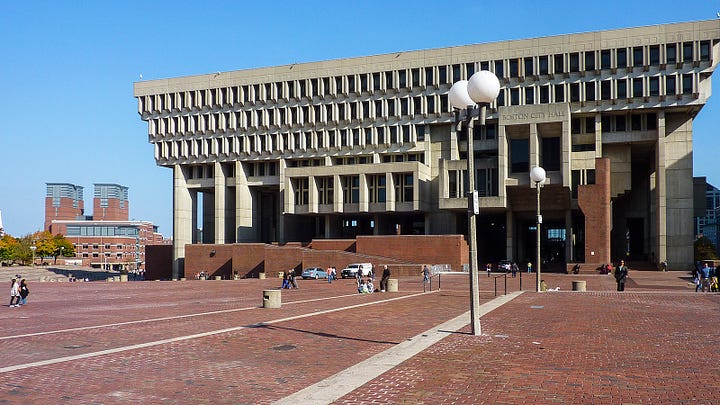

Concrete, it turns out, is at an inflection point: too dated to be modern, too recent to be classic. But for architects, it remains the ultimate test. It requires precision, confidence, and vision. And maybe, with some adaptation (think greener systems, more windows, actual upkeep), we’ll come to see these buildings not as mistakes, but monuments to an era of optimism and ambition.
As Lamster puts it: if we tear them all down, we don’t just lose concrete. We lose what it stood for.
5. The Journal: Lady Gaga, Low-Rise Jeans, and the Next Recession
Search “recession indicators” on TikTok and you’ll find Gen Z pointing to low-rise jeans, the return of Lady Gaga, and the rise of masters degrees as signs a downturn is coming. And while economists may roll their eyes, the logic isn’t totally off.
Technically, we’re not in a recession. But the economy is as much about feeling as it is about fundamentals, and Gen Z has grown up on economic instability: first, the Great Recession, and then, COVID.
Traditional indicators like the unemployment rate or yield curve take time to show up, so people have learned to look elsewhere. Think: the men’s underwear index, the lipstick effect, or the hemline theory (longer skirts in harder times).
Fashion blogger @databutmakeitfashion went viral for the post below on maxi skirts as a recession indicator. Others point to a shift in pop: the return of upbeat, escapist tracks a la 2008’s Just Dance.
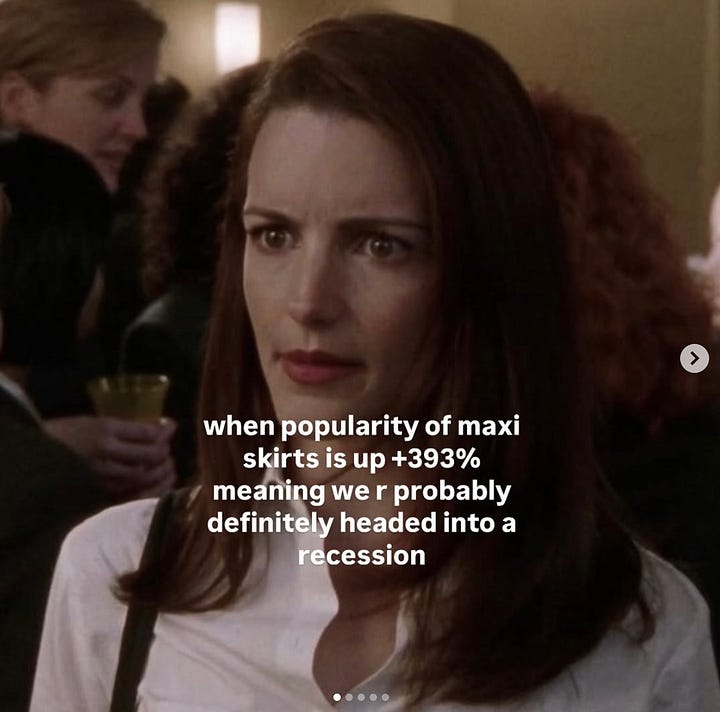
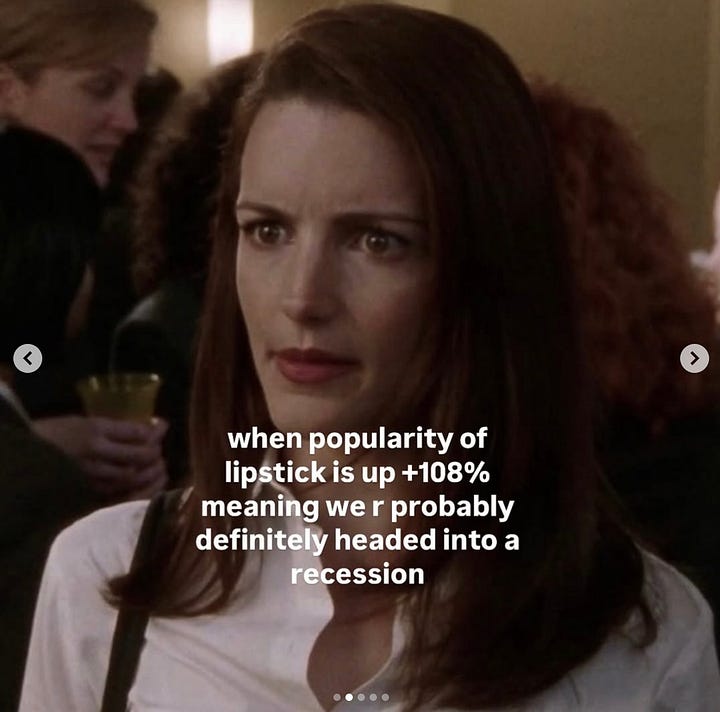
Sure, correlation doesn’t equal causation. But even economists rely on consumer sentiment. And when everyone’s bracing for a downturn, behavior starts to shift. So maybe low-rise jeans won’t tank the economy... But in a world where mood drives markets, they might be worth watching.
Please drop your recession indicators in the comments.
Also worth a listen: The Journal’s episode this week on egg prices and Cal-Maine, the country’s biggest egg producer.
6. How I Built This: Calm
In 2024, the global meditation market hit $9B, with a quarter of that coming from meditation apps. One of the biggest winners? Calm. The app, now valued at $2B, didn’t start with a master plan. It started with two burned-out entrepreneurs and a shared interest in mindfulness.
Alex Tew and Michael Acton Smith both grew up in the UK. Alex made a name for himself with The Million Dollar Homepage, a viral stunt that actually worked. Michael launched an online gadget shop and later created Moshi Monsters. In the early 2010s, they were both tinkering with internet businesses that weren’t going anywhere, until they moved in together and started talking about what people really needed.
Alex had been meditating since his teens. He built donothingfor2minutes.com, which was exactly what it sounds like. If you succeeded in sitting still, it asked for your email. 100,000 people signed up, which would later become the launch list for Calm.
But first, they needed the domain. Calm.com was owned by someone in England who didn’t want to sell—until he did a few years later for $140,000. Michael used his house deposit to buy it. A huge bet, but both founders believed the world needed more Calm.
Calm officially launched in 2012, to lukewarm reception from investors (at best). The general consensus? “An admirable mission, but a terrible business idea.” After over 100 meetings, they raised $400K from 12 people. With this, they launched the app version.
The real shift came with The Daily Calm, a new meditation released every day, narrated by Tamara Levitt. Daily content turned into daily engagement. But still, investors didn’t buy it. Calm looked like a content app with no moat. Something YouTube could easily replace.
So, Alex and Michael stayed scrappy. They made the business profitable out of necessity, paying close attention to how people were using it. One big surprise: users were falling asleep to Tamara’s voice (guilty). At first, they thought that was a problem. This isn’t how you meditate! But then they leaned in, and Sleep Stories were born. This, again, expanded their reach massively.
Then came the celebrity narrators: Stephen Fry. Matthew McConaughey. LeBron James. Harry Styles. Suddenly, Calm wasn’t just a meditation app; it was a cultural brand. These voices brought headlines, downloads, and legitimacy.
Eventually, Calm won Apple’s App of the Year and acquired a company called Ripple to expand into healthcare. Ripple’s CEO took over day-to-day leadership, and Alex and Michael became Chairmen. They moved back to Europe, all the while Calm kept growing.
Calm didn’t win by being loud. It won by being exactly what the name promised: a counterbalance to the noise. A reminder that rest is productive, and presence is powerful.
Turns out, there’s big business in slowing down. What a powerful note to end on.
You can find all the podcast episodes in THIS Spotify playlist (thank you to Zoe for the incredible idea!).
Until Wednesday,
Taylor





